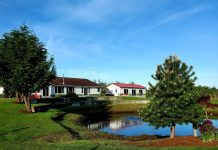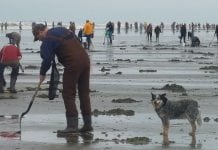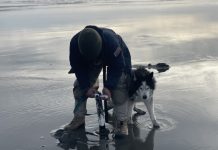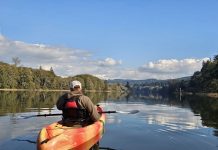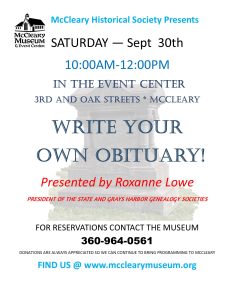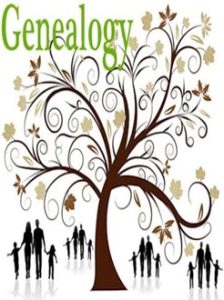This calendar is the place to find fun events happening throughout Grays Harbor County including Aberdeen, Hoquiam, Westport, Ocean Shores, Elma, Montesano and beyond.
Have an event that isn’t listed? Please email events@GraysHarborTalk.com with the following information:
- Name of Event
- Date, time and location (name of business if applicable and complete address)
- Organizer(s) name
- Cost
- URL to purchase tickets
- Website URL
- SHORT description of event
- Photo
Our editors will review and post within a few business days.
WDFW approves final coastal razor clam digs of the spring season beginning Thursday, May 4
OLYMPIA – Washington Department of Fish and Wildlife (WDFW) shellfish managers today confirmed the final coastal razor clam digs of the season can proceed as planned from May 4-14.
“This last tide series had lots of happy diggers, and we’re anticipating more of the same for this upcoming tide series to close out the season,” said Bryce Blumenthal, a WDFW coastal shellfish biologist.
On all open beaches – Long Beach, Twin Harbors, Mocrocks, and Copalis – the daily limit is 20 razor clams instead of the usual 15. Each digger’s clams must be kept in a separate container, and all diggers must keep the first 20 clams they dig, regardless of size or condition.
Not all beaches are open for every dig, so diggers are encouraged to make sure their intended destination is open before heading out. The most successful digging occurs within two hours before the listed time of low tide.
Digging is allowed from midnight until 12 p.m. only on May 4-10. Since low tides on May 11-14 are near or after 12 p.m., digging will be allowed from 4 a.m. until 4 p.m. for those specific days only.
The following digs during morning (a.m.) low tides are scheduled (digging allowed 4 a.m. until 4 p.m. on May 11-14 only):
- May 4, Thursday, 6:32 AM; -0.2 feet; Long Beach, Twin Harbors, Copalis
- May 5, Friday, 7:10 AM; -0.8 feet; Long Beach, Twin Harbors, Mocrocks
- May 6, Saturday, 7:49 AM; -1.2 feet; Long Beach, Twin Harbors, Copalis
- May 7, Sunday, 8:31 AM; -1.4 feet; Long Beach, Twin Harbors, Mocrocks
- May 8, Monday, 9:15 AM; -1.5 feet; Long Beach, Twin Harbors, Copalis
- May 9, Tuesday, 10:03 AM; -1.3 feet; Long Beach, Twin Harbors, Mocrocks
- May 10, Wednesday, 10:57 AM; -1.0 feet; Long Beach, Twin Harbors, Copalis
- May 11, Thursday, 11:56 AM; -0.6 feet; Long Beach, Twin Harbors, Mocrocks (digging allowed 4 AM until 4 PM only)
- May 12, Friday, 12:59 PM; -0.2 feet; Long Beach, Twin Harbors, Copalis (digging allowed 4 AM until 4 PM only)
- May 13, Saturday, 2:03 PM; 0.1 feet; Long Beach, Twin Harbors, Mocrocks (digging allowed 4 AM until 4 PM only)
- May 14, Sunday, 3:03 PM; 0.4 feet; Long Beach, Twin Harbors, Copalis (digging allowed 4 AM until 4 PM only)
WDFW plans to announce tentative digging opportunities in early fall for the 2023-2024 season via the WDFW razor clam webpage. This summer, WDFW will monitor, domoic acid, a natural marine toxin produced by certain types of marine algae, that can be harmful or fatal if consumed in sufficient quantities. More information about domoic acid, as well as current levels at ocean beaches, can be found on WDFW’s domoic acid webpage and on the DOH webpage.
As in past years, WDFW is asking beachgoers to avoid disturbing nesting snowy plovers – a small bird with gray wings and a white breast – by staying out of the dunes and posted areas along the southwest coast. Snowy plover nests are nearly invisible, and it is vital to give birds the space to live and thrive during nesting period, especially along the southern end on Twin Harbors – known as Midway Beach – and the north end of Long Beach.
Avoid leaving leftover food or trash – which attracts predators – on the beach and picnic areas, keep pets on a leash, stay out of dunes, and avoid areas which are clearly marked with posted signs. When driving on the beach, please respect the 25 MPH speed limit and enter only at designated access points. Stay on the hard-packed sand near the high tide line to avoid crushing clam beds and snowy plover nests.
Several sections of coastal beaches are closed to driving between now through Labor Day, except on days and hours when the recreational razor clam digging is open. These areas are clearly marked with signs.
To participate, razor clam diggers must purchase their new 2023-2024 recreational fishing or shellfishing licenses, available from hundreds of license vendors around the state. All diggers age 15 or older must have an applicable fishing license to harvest razor clams on any beach. To be notified of in-season rule changes as they are announced sign up for email notifications at wdfw.wa.gov/about/lists.
The Washington Department of Fish and Wildlife works to preserve, protect, and perpetuate fish, wildlife and ecosystems while providing sustainable fish and wildlife recreational and commercial opportunities.
WDFW approves final coastal razor clam digs of the spring season beginning Thursday, May 4
OLYMPIA – Washington Department of Fish and Wildlife (WDFW) shellfish managers today confirmed the final coastal razor clam digs of the season can proceed as planned from May 4-14.
“This last tide series had lots of happy diggers, and we’re anticipating more of the same for this upcoming tide series to close out the season,” said Bryce Blumenthal, a WDFW coastal shellfish biologist.
On all open beaches – Long Beach, Twin Harbors, Mocrocks, and Copalis – the daily limit is 20 razor clams instead of the usual 15. Each digger’s clams must be kept in a separate container, and all diggers must keep the first 20 clams they dig, regardless of size or condition.
Not all beaches are open for every dig, so diggers are encouraged to make sure their intended destination is open before heading out. The most successful digging occurs within two hours before the listed time of low tide.
Digging is allowed from midnight until 12 p.m. only on May 4-10. Since low tides on May 11-14 are near or after 12 p.m., digging will be allowed from 4 a.m. until 4 p.m. for those specific days only.
The following digs during morning (a.m.) low tides are scheduled (digging allowed 4 a.m. until 4 p.m. on May 11-14 only):
- May 4, Thursday, 6:32 AM; -0.2 feet; Long Beach, Twin Harbors, Copalis
- May 5, Friday, 7:10 AM; -0.8 feet; Long Beach, Twin Harbors, Mocrocks
- May 6, Saturday, 7:49 AM; -1.2 feet; Long Beach, Twin Harbors, Copalis
- May 7, Sunday, 8:31 AM; -1.4 feet; Long Beach, Twin Harbors, Mocrocks
- May 8, Monday, 9:15 AM; -1.5 feet; Long Beach, Twin Harbors, Copalis
- May 9, Tuesday, 10:03 AM; -1.3 feet; Long Beach, Twin Harbors, Mocrocks
- May 10, Wednesday, 10:57 AM; -1.0 feet; Long Beach, Twin Harbors, Copalis
- May 11, Thursday, 11:56 AM; -0.6 feet; Long Beach, Twin Harbors, Mocrocks (digging allowed 4 AM until 4 PM only)
- May 12, Friday, 12:59 PM; -0.2 feet; Long Beach, Twin Harbors, Copalis (digging allowed 4 AM until 4 PM only)
- May 13, Saturday, 2:03 PM; 0.1 feet; Long Beach, Twin Harbors, Mocrocks (digging allowed 4 AM until 4 PM only)
- May 14, Sunday, 3:03 PM; 0.4 feet; Long Beach, Twin Harbors, Copalis (digging allowed 4 AM until 4 PM only)
WDFW plans to announce tentative digging opportunities in early fall for the 2023-2024 season via the WDFW razor clam webpage. This summer, WDFW will monitor, domoic acid, a natural marine toxin produced by certain types of marine algae, that can be harmful or fatal if consumed in sufficient quantities. More information about domoic acid, as well as current levels at ocean beaches, can be found on WDFW’s domoic acid webpage and on the DOH webpage.
As in past years, WDFW is asking beachgoers to avoid disturbing nesting snowy plovers – a small bird with gray wings and a white breast – by staying out of the dunes and posted areas along the southwest coast. Snowy plover nests are nearly invisible, and it is vital to give birds the space to live and thrive during nesting period, especially along the southern end on Twin Harbors – known as Midway Beach – and the north end of Long Beach.
Avoid leaving leftover food or trash – which attracts predators – on the beach and picnic areas, keep pets on a leash, stay out of dunes, and avoid areas which are clearly marked with posted signs. When driving on the beach, please respect the 25 MPH speed limit and enter only at designated access points. Stay on the hard-packed sand near the high tide line to avoid crushing clam beds and snowy plover nests.
Several sections of coastal beaches are closed to driving between now through Labor Day, except on days and hours when the recreational razor clam digging is open. These areas are clearly marked with signs.
To participate, razor clam diggers must purchase their new 2023-2024 recreational fishing or shellfishing licenses, available from hundreds of license vendors around the state. All diggers age 15 or older must have an applicable fishing license to harvest razor clams on any beach. To be notified of in-season rule changes as they are announced sign up for email notifications at wdfw.wa.gov/about/lists.
The Washington Department of Fish and Wildlife works to preserve, protect, and perpetuate fish, wildlife and ecosystems while providing sustainable fish and wildlife recreational and commercial opportunities.
WDFW approves final coastal razor clam digs of the spring season beginning Thursday, May 4
OLYMPIA – Washington Department of Fish and Wildlife (WDFW) shellfish managers today confirmed the final coastal razor clam digs of the season can proceed as planned from May 4-14.
“This last tide series had lots of happy diggers, and we’re anticipating more of the same for this upcoming tide series to close out the season,” said Bryce Blumenthal, a WDFW coastal shellfish biologist.
On all open beaches – Long Beach, Twin Harbors, Mocrocks, and Copalis – the daily limit is 20 razor clams instead of the usual 15. Each digger’s clams must be kept in a separate container, and all diggers must keep the first 20 clams they dig, regardless of size or condition.
Not all beaches are open for every dig, so diggers are encouraged to make sure their intended destination is open before heading out. The most successful digging occurs within two hours before the listed time of low tide.
Digging is allowed from midnight until 12 p.m. only on May 4-10. Since low tides on May 11-14 are near or after 12 p.m., digging will be allowed from 4 a.m. until 4 p.m. for those specific days only.
The following digs during morning (a.m.) low tides are scheduled (digging allowed 4 a.m. until 4 p.m. on May 11-14 only):
- May 4, Thursday, 6:32 AM; -0.2 feet; Long Beach, Twin Harbors, Copalis
- May 5, Friday, 7:10 AM; -0.8 feet; Long Beach, Twin Harbors, Mocrocks
- May 6, Saturday, 7:49 AM; -1.2 feet; Long Beach, Twin Harbors, Copalis
- May 7, Sunday, 8:31 AM; -1.4 feet; Long Beach, Twin Harbors, Mocrocks
- May 8, Monday, 9:15 AM; -1.5 feet; Long Beach, Twin Harbors, Copalis
- May 9, Tuesday, 10:03 AM; -1.3 feet; Long Beach, Twin Harbors, Mocrocks
- May 10, Wednesday, 10:57 AM; -1.0 feet; Long Beach, Twin Harbors, Copalis
- May 11, Thursday, 11:56 AM; -0.6 feet; Long Beach, Twin Harbors, Mocrocks (digging allowed 4 AM until 4 PM only)
- May 12, Friday, 12:59 PM; -0.2 feet; Long Beach, Twin Harbors, Copalis (digging allowed 4 AM until 4 PM only)
- May 13, Saturday, 2:03 PM; 0.1 feet; Long Beach, Twin Harbors, Mocrocks (digging allowed 4 AM until 4 PM only)
- May 14, Sunday, 3:03 PM; 0.4 feet; Long Beach, Twin Harbors, Copalis (digging allowed 4 AM until 4 PM only)
WDFW plans to announce tentative digging opportunities in early fall for the 2023-2024 season via the WDFW razor clam webpage. This summer, WDFW will monitor, domoic acid, a natural marine toxin produced by certain types of marine algae, that can be harmful or fatal if consumed in sufficient quantities. More information about domoic acid, as well as current levels at ocean beaches, can be found on WDFW’s domoic acid webpage and on the DOH webpage.
As in past years, WDFW is asking beachgoers to avoid disturbing nesting snowy plovers – a small bird with gray wings and a white breast – by staying out of the dunes and posted areas along the southwest coast. Snowy plover nests are nearly invisible, and it is vital to give birds the space to live and thrive during nesting period, especially along the southern end on Twin Harbors – known as Midway Beach – and the north end of Long Beach.
Avoid leaving leftover food or trash – which attracts predators – on the beach and picnic areas, keep pets on a leash, stay out of dunes, and avoid areas which are clearly marked with posted signs. When driving on the beach, please respect the 25 MPH speed limit and enter only at designated access points. Stay on the hard-packed sand near the high tide line to avoid crushing clam beds and snowy plover nests.
Several sections of coastal beaches are closed to driving between now through Labor Day, except on days and hours when the recreational razor clam digging is open. These areas are clearly marked with signs.
To participate, razor clam diggers must purchase their new 2023-2024 recreational fishing or shellfishing licenses, available from hundreds of license vendors around the state. All diggers age 15 or older must have an applicable fishing license to harvest razor clams on any beach. To be notified of in-season rule changes as they are announced sign up for email notifications at wdfw.wa.gov/about/lists.
The Washington Department of Fish and Wildlife works to preserve, protect, and perpetuate fish, wildlife and ecosystems while providing sustainable fish and wildlife recreational and commercial opportunities.
WDFW approves final coastal razor clam digs of the spring season beginning Thursday, May 4
OLYMPIA – Washington Department of Fish and Wildlife (WDFW) shellfish managers today confirmed the final coastal razor clam digs of the season can proceed as planned from May 4-14.
“This last tide series had lots of happy diggers, and we’re anticipating more of the same for this upcoming tide series to close out the season,” said Bryce Blumenthal, a WDFW coastal shellfish biologist.
On all open beaches – Long Beach, Twin Harbors, Mocrocks, and Copalis – the daily limit is 20 razor clams instead of the usual 15. Each digger’s clams must be kept in a separate container, and all diggers must keep the first 20 clams they dig, regardless of size or condition.
Not all beaches are open for every dig, so diggers are encouraged to make sure their intended destination is open before heading out. The most successful digging occurs within two hours before the listed time of low tide.
Digging is allowed from midnight until 12 p.m. only on May 4-10. Since low tides on May 11-14 are near or after 12 p.m., digging will be allowed from 4 a.m. until 4 p.m. for those specific days only.
The following digs during morning (a.m.) low tides are scheduled (digging allowed 4 a.m. until 4 p.m. on May 11-14 only):
- May 4, Thursday, 6:32 AM; -0.2 feet; Long Beach, Twin Harbors, Copalis
- May 5, Friday, 7:10 AM; -0.8 feet; Long Beach, Twin Harbors, Mocrocks
- May 6, Saturday, 7:49 AM; -1.2 feet; Long Beach, Twin Harbors, Copalis
- May 7, Sunday, 8:31 AM; -1.4 feet; Long Beach, Twin Harbors, Mocrocks
- May 8, Monday, 9:15 AM; -1.5 feet; Long Beach, Twin Harbors, Copalis
- May 9, Tuesday, 10:03 AM; -1.3 feet; Long Beach, Twin Harbors, Mocrocks
- May 10, Wednesday, 10:57 AM; -1.0 feet; Long Beach, Twin Harbors, Copalis
- May 11, Thursday, 11:56 AM; -0.6 feet; Long Beach, Twin Harbors, Mocrocks (digging allowed 4 AM until 4 PM only)
- May 12, Friday, 12:59 PM; -0.2 feet; Long Beach, Twin Harbors, Copalis (digging allowed 4 AM until 4 PM only)
- May 13, Saturday, 2:03 PM; 0.1 feet; Long Beach, Twin Harbors, Mocrocks (digging allowed 4 AM until 4 PM only)
- May 14, Sunday, 3:03 PM; 0.4 feet; Long Beach, Twin Harbors, Copalis (digging allowed 4 AM until 4 PM only)
WDFW plans to announce tentative digging opportunities in early fall for the 2023-2024 season via the WDFW razor clam webpage. This summer, WDFW will monitor, domoic acid, a natural marine toxin produced by certain types of marine algae, that can be harmful or fatal if consumed in sufficient quantities. More information about domoic acid, as well as current levels at ocean beaches, can be found on WDFW’s domoic acid webpage and on the DOH webpage.
As in past years, WDFW is asking beachgoers to avoid disturbing nesting snowy plovers – a small bird with gray wings and a white breast – by staying out of the dunes and posted areas along the southwest coast. Snowy plover nests are nearly invisible, and it is vital to give birds the space to live and thrive during nesting period, especially along the southern end on Twin Harbors – known as Midway Beach – and the north end of Long Beach.
Avoid leaving leftover food or trash – which attracts predators – on the beach and picnic areas, keep pets on a leash, stay out of dunes, and avoid areas which are clearly marked with posted signs. When driving on the beach, please respect the 25 MPH speed limit and enter only at designated access points. Stay on the hard-packed sand near the high tide line to avoid crushing clam beds and snowy plover nests.
Several sections of coastal beaches are closed to driving between now through Labor Day, except on days and hours when the recreational razor clam digging is open. These areas are clearly marked with signs.
To participate, razor clam diggers must purchase their new 2023-2024 recreational fishing or shellfishing licenses, available from hundreds of license vendors around the state. All diggers age 15 or older must have an applicable fishing license to harvest razor clams on any beach. To be notified of in-season rule changes as they are announced sign up for email notifications at wdfw.wa.gov/about/lists.
The Washington Department of Fish and Wildlife works to preserve, protect, and perpetuate fish, wildlife and ecosystems while providing sustainable fish and wildlife recreational and commercial opportunities.
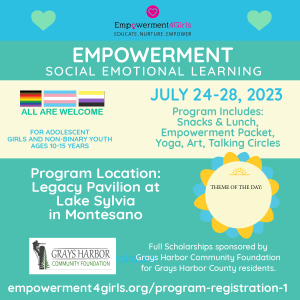
During this week-long program, participants will practice research-based emotional regulation tools to increase self-awareness and resilience. Through talking circles, guided art projects, community-building games, and mindfulness activities, youth will learn about expressing themselves, fostering healthy relationships, the importance of self-care, and responsibility to our communities and our world.
The registration fee is $0 thanks to sponsorship from Grays Harbor Community Foundation.

During this week-long program, participants will practice research-based emotional regulation tools to increase self-awareness and resilience. Through talking circles, guided art projects, community-building games, and mindfulness activities, youth will learn about expressing themselves, fostering healthy relationships, the importance of self-care, and responsibility to our communities and our world.
The registration fee is $0 thanks to sponsorship from Grays Harbor Community Foundation.

During this week-long program, participants will practice research-based emotional regulation tools to increase self-awareness and resilience. Through talking circles, guided art projects, community-building games, and mindfulness activities, youth will learn about expressing themselves, fostering healthy relationships, the importance of self-care, and responsibility to our communities and our world.
The registration fee is $0 thanks to sponsorship from Grays Harbor Community Foundation.

During this week-long program, participants will practice research-based emotional regulation tools to increase self-awareness and resilience. Through talking circles, guided art projects, community-building games, and mindfulness activities, youth will learn about expressing themselves, fostering healthy relationships, the importance of self-care, and responsibility to our communities and our world.
The registration fee is $0 thanks to sponsorship from Grays Harbor Community Foundation.

During this week-long program, participants will practice research-based emotional regulation tools to increase self-awareness and resilience. Through talking circles, guided art projects, community-building games, and mindfulness activities, youth will learn about expressing themselves, fostering healthy relationships, the importance of self-care, and responsibility to our communities and our world.
The registration fee is $0 thanks to sponsorship from Grays Harbor Community Foundation.
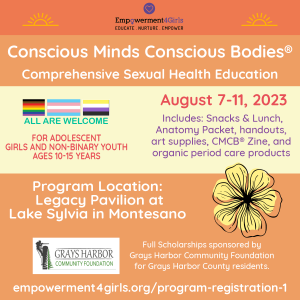
**Registration fees are $0 thanks to sponsorship from Grays Harbor Community Foundation.
Program Overview
Our curriculum is unbiased, factual sexual health information supported by the Washington State Health Education k-12 Standards. Participants will learn about anatomical terms, pregnancy and STI prevention, puberty changes, gender identity, gender norms and social pressure, sexual orientation, and how to be an ally.
The social-emotional skills taught in CMCB® align with the Washington State Social Emotional Learning (SEL) standards for k-12, which include practicing giving and denying consent, social media moderation, and using nonviolent communication to set and maintain boundaries. Through experiential learning, participants will practice several evidence-based self-regulation and self-care strategies, including mindfulness activities, intentional social interactions and protective measures for their mental health.
?
Our sex-positive approach encourages participants to be confident self-advocates for their reproductive health. By the end of the program, participants will have developed their body literacy practice, learned several self-regulation strategies and practiced advocating for themselves and others to create a more just society.
Learning topics:
Anatomy and Puberty
Consent and Boundaries
Gender Identity
Sexual Orientation
Stages of Pregnancy
Building Confidence
Social Media Awareness
Pregnancy and STI Prevention

**Registration fees are $0 thanks to sponsorship from Grays Harbor Community Foundation.
Program Overview
Our curriculum is unbiased, factual sexual health information supported by the Washington State Health Education k-12 Standards. Participants will learn about anatomical terms, pregnancy and STI prevention, puberty changes, gender identity, gender norms and social pressure, sexual orientation, and how to be an ally.
The social-emotional skills taught in CMCB® align with the Washington State Social Emotional Learning (SEL) standards for k-12, which include practicing giving and denying consent, social media moderation, and using nonviolent communication to set and maintain boundaries. Through experiential learning, participants will practice several evidence-based self-regulation and self-care strategies, including mindfulness activities, intentional social interactions and protective measures for their mental health.
?
Our sex-positive approach encourages participants to be confident self-advocates for their reproductive health. By the end of the program, participants will have developed their body literacy practice, learned several self-regulation strategies and practiced advocating for themselves and others to create a more just society.
Learning topics:
Anatomy and Puberty
Consent and Boundaries
Gender Identity
Sexual Orientation
Stages of Pregnancy
Building Confidence
Social Media Awareness
Pregnancy and STI Prevention

**Registration fees are $0 thanks to sponsorship from Grays Harbor Community Foundation.
Program Overview
Our curriculum is unbiased, factual sexual health information supported by the Washington State Health Education k-12 Standards. Participants will learn about anatomical terms, pregnancy and STI prevention, puberty changes, gender identity, gender norms and social pressure, sexual orientation, and how to be an ally.
The social-emotional skills taught in CMCB® align with the Washington State Social Emotional Learning (SEL) standards for k-12, which include practicing giving and denying consent, social media moderation, and using nonviolent communication to set and maintain boundaries. Through experiential learning, participants will practice several evidence-based self-regulation and self-care strategies, including mindfulness activities, intentional social interactions and protective measures for their mental health.
?
Our sex-positive approach encourages participants to be confident self-advocates for their reproductive health. By the end of the program, participants will have developed their body literacy practice, learned several self-regulation strategies and practiced advocating for themselves and others to create a more just society.
Learning topics:
Anatomy and Puberty
Consent and Boundaries
Gender Identity
Sexual Orientation
Stages of Pregnancy
Building Confidence
Social Media Awareness
Pregnancy and STI Prevention

**Registration fees are $0 thanks to sponsorship from Grays Harbor Community Foundation.
Program Overview
Our curriculum is unbiased, factual sexual health information supported by the Washington State Health Education k-12 Standards. Participants will learn about anatomical terms, pregnancy and STI prevention, puberty changes, gender identity, gender norms and social pressure, sexual orientation, and how to be an ally.
The social-emotional skills taught in CMCB® align with the Washington State Social Emotional Learning (SEL) standards for k-12, which include practicing giving and denying consent, social media moderation, and using nonviolent communication to set and maintain boundaries. Through experiential learning, participants will practice several evidence-based self-regulation and self-care strategies, including mindfulness activities, intentional social interactions and protective measures for their mental health.
?
Our sex-positive approach encourages participants to be confident self-advocates for their reproductive health. By the end of the program, participants will have developed their body literacy practice, learned several self-regulation strategies and practiced advocating for themselves and others to create a more just society.
Learning topics:
Anatomy and Puberty
Consent and Boundaries
Gender Identity
Sexual Orientation
Stages of Pregnancy
Building Confidence
Social Media Awareness
Pregnancy and STI Prevention

**Registration fees are $0 thanks to sponsorship from Grays Harbor Community Foundation.
Program Overview
Our curriculum is unbiased, factual sexual health information supported by the Washington State Health Education k-12 Standards. Participants will learn about anatomical terms, pregnancy and STI prevention, puberty changes, gender identity, gender norms and social pressure, sexual orientation, and how to be an ally.
The social-emotional skills taught in CMCB® align with the Washington State Social Emotional Learning (SEL) standards for k-12, which include practicing giving and denying consent, social media moderation, and using nonviolent communication to set and maintain boundaries. Through experiential learning, participants will practice several evidence-based self-regulation and self-care strategies, including mindfulness activities, intentional social interactions and protective measures for their mental health.
?
Our sex-positive approach encourages participants to be confident self-advocates for their reproductive health. By the end of the program, participants will have developed their body literacy practice, learned several self-regulation strategies and practiced advocating for themselves and others to create a more just society.
Learning topics:
Anatomy and Puberty
Consent and Boundaries
Gender Identity
Sexual Orientation
Stages of Pregnancy
Building Confidence
Social Media Awareness
Pregnancy and STI Prevention
The Harborside Chats are guided dialogues fostering civil conversation and addressing vital issues within Grays Harbor County. Our mission is to amplify diverse voices and share constructive ideas with the goal of reducing civic division and political polarization in our communities. To learn more about The Dialogue Project, please visit our website: https://www.drcghp.org/dialogue-project
Ways to Engage
Multiple Avenues, One Mission!
- Attend the Cosmopolis Chat and future guided conversations!
- Scout or sponsor event locations for upcoming dialogues!
- Volunteer as an Event Assistant!
- Donate to support the Dialogue Project!
- Amplify the project as a Dialogue Project Ambassador!
Please join us, and invite your network to this unique, innovative event designed to connect our community and collaborate on solutions for all!
Communities Thrive When Dialogue Is Alive!
Humanities Washington Speaker Event: Homelessness and the Meaning of Home.
Speaker: Josephine Ensign.
This is an online virtual program. You will receive a reminder email along with the link to view from home. You may come to the library to watch this Online Event.
Registrants will have access to the recording for up to 3 days following the event.
Loss of a home, whether through financial difficulties, divorce, illness,
or natural disasters like wildfires, is a widespread and growing problem affecting all of us.
Often thought of as only an urban problem, homelessness also occurs in suburban and rural areas throughout Washington State. What are the historical roots of homelessness, and what lessons can we learn from them? What are the common meanings of home to us, and how can we apply those meanings to our responses to homelessness in our communities?
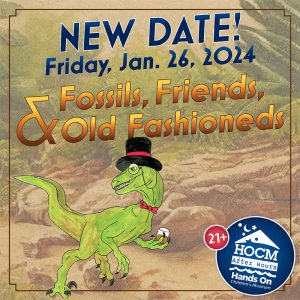
We’re back from extinction and we’ve changed our name!
Join us for a Dino-mite night at our Adults Only (21+) special event! Same great fun with an all-new-name HOCM After Hours. (Move over Adult Swim!) This is the perfect time for fossils, friends, and old fashioneds! Dig up your curiosity, dust off your khakis, and shake your bones to DJ Wes Jamieson. Unearth the secrets of paleontology with fossil experts from the Fossil Team PDX. Meet birds of prey with the Raptor Ambassadors and The Falconer. Try your hand at whiskey trivia, learn about distilling and craft your own infusion. Go back in time to the dawn of the dinosaurs and make a dino egg bath bomb and create a wax fossil cast.
Check out our website for more details and activities!
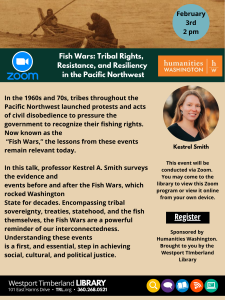
Fish Wars: Tribal Rights, Resistance, and Resiliency in the Pacific Northwest-Kestrel Smith
In the 1960s and 70s, tribes throughout the Pacific Northwest launched protests and acts of civil disobedience to pressure the government to recognize their fishing rights. Now known as the “Fish Wars,” the lessons from these events remain relevant today.? In this talk, professor Kestrel A. Smith surveys the evidence and events before and after the Fish Wars, which rocked Washington State for decades. Encompassing tribal sovereignty, treaties, statehood, and the fish themselves, the Fish Wars are a powerful reminder of our interconnectedness. Understanding these events is a first, and essential, step in achieving social, cultural, and political justice.

And It Has Pockets! The Battle for Women’s Clothing Equality – Diane Johnston
How many times have you heard someone wearing women’s clothing exclaim, “And it has pockets!” Comparisons have shown that modern garments designed for women have about half the storage space of clothing designed for men. From their invention, pockets in women’s fashion have represented independence—so much so that in the 18th century, laws were enacted to strip women of their personal liberty by making the contents of their pockets the property of their husband. The right to have pockets went hand-in-hand with the right to vote. And people today are still speaking out about the inequality between men’s and women’s clothing based on this simple storage system.
Join costume designer Diane Johnston to dig into the pockets of the past, tracing the history of the humble pocket to determine if the battle for equality may still be decided by a few inches of extremely influential fabric.
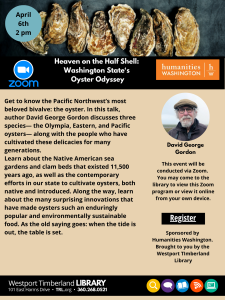
Humanities Washington Speaker Event: Heaven on the Half Shell: Washington State’s Oyster Odyssey.-David George Gordon
Get to know the Pacific Northwest’s most beloved bivalve: the oyster. In this talk, author David George Gordon discusses three species— the Olympia, Eastern, and Pacific oysters— along with the people who have cultivated these delicacies for many generations.
Learn about the Native American sea gardens and clam beds that existed 11,500 years ago, as well as the contemporary efforts in our state to cultivate oysters, both native and introduced. Along the way, learn about the many surprising innovations that have made oysters such an enduringly popular and environmentally sustainable food. As the old saying goes: when the tide is out, the table is set.














